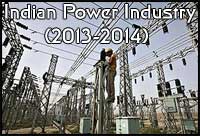The demand for electricity in the country has been growing at a rapid rate and is expected to increase further in the years to come with the rising population. Electricity production in India stood at 911.6 terra watt hour (TWh) in FY13, a four per cent growth over the previous fiscal. Over FY07-13, electricity production has expanded at a CAGR of 5.5 per cent. The Planning Commission's 12th Plan projects that total domestic energy production would reach 669.6 million tonnes of oil equivalent (MTOE) by 2016-17 and 844 MTOE by 2021-22.

The capacity addition target for 2013-14 is 1,198 MW of hydro power, 15,234 MW of thermal power and 2,000 MW of nuclear power. Total capacity target is 18,432 MW. The industry attracted foreign direct investment (FDI) worth Rs 37,335.68 crore (US$ 6.01 billion) during April 2000 to July 2013. The Government of India has set a target to generate 10,000 MW of power through solar energy by 2017. Wind energy accounts for an estimated 87 per cent of total installed capacity in renewable energy. There are plans to double wind power generation capacity to 20 GW by 2022. Biomass is the second largest source of renewable energy, accounting for 12 per cent of total installed capacity in renewable energy. Solar energy accounts for one per cent of total renewable energy installed capacity. However, solar energy potential stands at an estimated 5,000 TWh per annum.
 INDIAN power Industry AT A Glance IN 2012 - 2013
INDIAN power Industry AT A Glance IN 2012 - 2013
 INDIAN power Industry AT A Glance IN 2011 - 2012
INDIAN power Industry AT A Glance IN 2011 - 2012
 back to power INDUSTRies
back to power INDUSTRies
 |
INDIAN INDUSTRIES |



 INDIAN POWER INDUSTRY AT A GLANCE IN 2013 - 2014
INDIAN POWER INDUSTRY AT A GLANCE IN 2013 - 2014